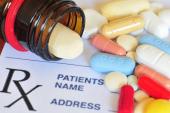A Simple Nudge Moves the Needle on Statin Prescribing
An EHR prompt shifts how information is delivered or framed to doctors, and it can have an impact on delivering optimal GDMT.

A little nudge, in this a case a decision aid issued through the electronic health record (EHR), can help bolster statin prescriptions for eligible patients, researchers found.
When combined with a reminder to patients to ask about statin therapy, these physician and patient prompts boosted statin prescribing even more among primary care physicians when compared with usual care, but simply reminding patients, via text message, didn’t have an impact on increasing statin prescribing.
Srinath Adusumalli, MD, MSHP (CVS Health, Philadelphia, PA), a cardiologist who led the study when working at Penn Medicine, said the goal of a nudge is to improve patient-oriented outcomes by steering physicians toward high-value care without restricting their choices. The study showed that combining reminders, in this case to patients and clinicians, can be synergistic when it comes to altering prescribing behavior.
“These types of nudges, both by using technology that is available, in this case electronic health records and automated texting, can be scalable and can serve as a template for making nudges a more-standard feature of healthcare,” he told TCTMD.
A nudge, said senior investigator Mitesh Patel, MD (Ascension Health, St. Louis, MO), is a subtle change in the way information is delivered, or choices are offered, that can have a huge impact on behavior.
“In the clinical setting, there are a lot of opportunities for nudges, because there are a lot of points at which patients and doctors are making decisions,” he told TCTMD. “Patients are going through the patient portal, they’re getting reminders about their visits with text messages, and they’re making decisions with verbal communication during the visits. Doctors are funneling all of their decisions through the electronic health record, so every decision they make is essentially influenced by [the information] in the drop-down [lists].”
Altering the information in these drop-down lists—such as changing the settings to make statin prescribing the default setting for eligible patients—can help facilitate the best outcomes for patients and physicians, say researchers. In this case, combining nudges to patients and clinicians can deliver care for treatments that remain underutilized in clinical practice.
“About half of Americans who are eligible for a statin are currently not prescribed one,” said Patel. “It’s a pretty large percentage given how remarkably effective statins are—they reduce mortality, myocardial infarction, stroke, readmissions, all by 40% or more, and they have very little side effects. . . . Given how impactful statins are, the low [rate of] side effects, it’s a big problem that only about half of people who could benefit are not taking them.”
Part of the ‘Nudge Unit’
The study, published online this week in JAMA Cardiology, was a cluster-randomized clinical trial set among 28 primary care practices in Pennsylvania and New Jersey. It’s part of a broader program at the Penn Medicine Nudge Unit, which is the world’s first behavioral science team included in a health system. The unit, founded by and formerly led by Patel, is intended to take insights from behavioral and implementation science then use those to develop and implement nudges for clinical practice.
Adusumalli said the goal of these reminders is to make the right thing the easy thing to do. “One of the guiding principles we’ve used, for example, is that the nudges should be transparent to those who are being nudged and aligned with the welfare of those being nudged,” he said.
For this study, investigators wanted to test whether nudges to physicians and/or patients could influence statin prescribing for eligible patients. The clinical practices were randomized to one of four interventions: usual care (40 clinicians, 1,032 patients), patient nudge alone (44 clinicians, 1,181 patients), clinician nudge alone (32 clinicians, 981 patients), and combined patient/clinician nudges (41 clinicians, 937 patients).
The nudge for physicians was composed of two parts. First, they received an active choice prompt in the EHR which popped up when they entered the ordering section. The prompt described the guideline criteria for statin therapy and included the patient’s 10-year risk of atherosclerotic cardiovascular disease. The prompt also provided options for a statin dose based on clinical criteria. The second part involved monthly feedback that informed clinicians of their prescribing patterns and how they compared with others at Penn Medicine when it came to prescribing statins to eligible patients.
For the patients, the nudge was a text message sent 4 days before their appointment that informed them of an important message about heart health. If patients were willing to communicate via text, they were told that “guidelines indicate you should be taking a statin to reduce the chance of a heart attack.” The text informed them of the benefits of lowering LDL cholesterol and rare adverse effects that may occur with statins (but go away upon stopping the medication).
In the 1-year period prior to the intervention, statins were prescribed to 5.6% of patients in the usual-care group, 4.8% in the patient-nudge group, 6.0% in the clinician-nudge group, and 4.7% in the combined group. During the intervention period, statins were prescribed to 7.3% of patients treated with usual care, 8.5% of patients who received a nudge, 13.0% of patients in the clinician-nudge group, and 15.5% of patients in combined-nudge group.
In the main adjusted analysis that compared the intervention to usual care, there were significant increases in statin prescribing for those randomized to the physician-nudge group (adjusted absolute increase of 5.5%; P = 0.01) and in the combined patient/physician-nudge group (adjusted absolute increase of 7.2%; P = 0.001). There was no impact on statin prescribing among patients randomized to practices where they alone received the reminder.
Stakeholder Engagement Is Key
While the rise in rates of statin prescribing might appear low, Patel noted that 70% of these patients treated within the Penn Medicine system had already been prescribed the medication. Their trial, he said, targeted the remaining patients. “This last 30% is really hard to move,” he said. “If you’re in the control group, it’s only 5% of patients, increasing to about 6% or 7% of people who get prescribed a statin. To get to 15%, almost a tripling, is really impressive given how subtle these nudges are.”
Adusumalli added that the eligible primary care patients not currently taking statins are not the “lowest-hanging fruit” and require greater efforts to get them treated with the lipid-lowering therapy. The nudge, in this group, was particularly effective, he said.
To TCTMD, Patel explained that while the patient reminder alone wasn’t effective, the effect may have been hampered by the healthcare system’s consent process over unsecured text messaging. For example, patients had to opt in to receiving the text message about statin therapy, but only one-third agreed to communicate via text. As a result, the remaining patients didn’t receive any nudge about the guidelines and their eligibility for statin therapy, and this may have “dampened” the potential effect.
Overall, Patel said the approach they tested could be widely adopted in other settings because the nudges were automated through the EHR. “It’s just a matter of displaying the information and using the peer-comparison approach,” he said. “Also, many health systems are regularly sending text messages. People get them as appointment reminders, but ever since the COVID-19 pandemic, they’re being used to help patients prepare for clinical discussions.”
Adusumalli emphasized that the context-specific statin prompts were codesigned by the nudge unit in collaboration with frontline physicians and primary care leadership. “Stakeholder engagement is key,” he said, referring to the success seen in this study.
In an editorial, Faraz Ahmad, MD, MS, and Stephen Persell, MD (both Northwestern University Feinberg School of Medicine, Chicago, IL), point out that digital nudges have been shown to improve prescriptions of guideline-directed medical therapy in heart failure and encourage greater uptake of influenza vaccinations. They also state that the patient nudge warrants further investigation before giving up on it, noting that it’s still uncertain whether timing and total number of text messages might influence decisions or the percentage of patients who opt in for receiving the digital nudge.
Michael O’Riordan is the Managing Editor for TCTMD. He completed his undergraduate degrees at Queen’s University in Kingston, ON, and…
Read Full BioSources
Adusumalli S, Kanter GP, Small DS, et al. Effects of nudges to clinicians, patients, or both to increase statin prescribing: a cluster randomized clinical trial. JAMA Cardiol. 2022;Epub ahead of print.
Ahmad FS, Persell SD. Nudging to improve cardiovascular care—clinicians, patients, or both. JAMA Cardiol. 2022;Epub ahead of print.
Disclosures
- Patel reports owning and receiving personal fees from Catalyst Health LLC and serving on an advisory board for and receiving personal fees from Humana.
- Adusumalli is an employee of CVS Health.
- Ahmad reports consulting fees from Teladoc Livongo and Pfizer.
- Ahmad reports consulting fees from Teladoc Livongo and Pfizer.





Comments